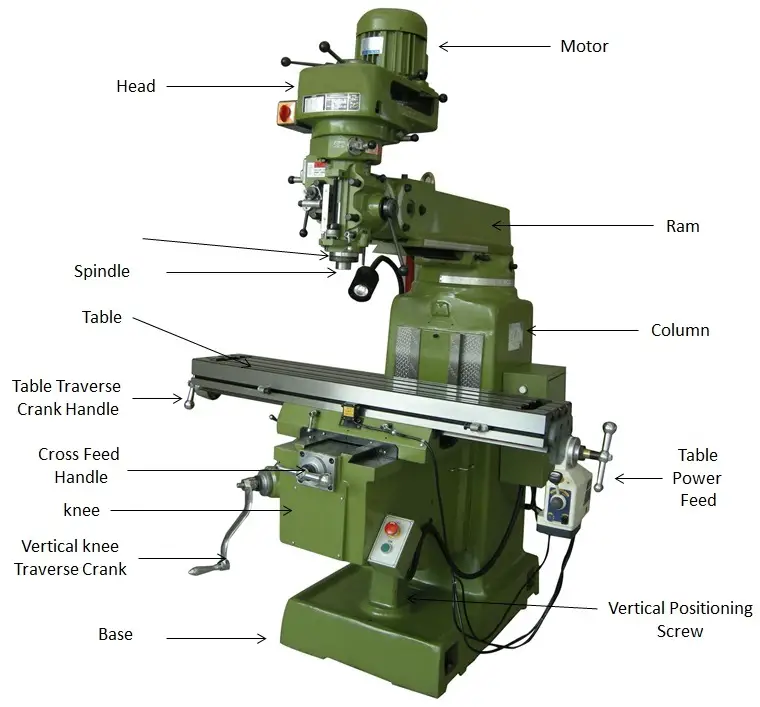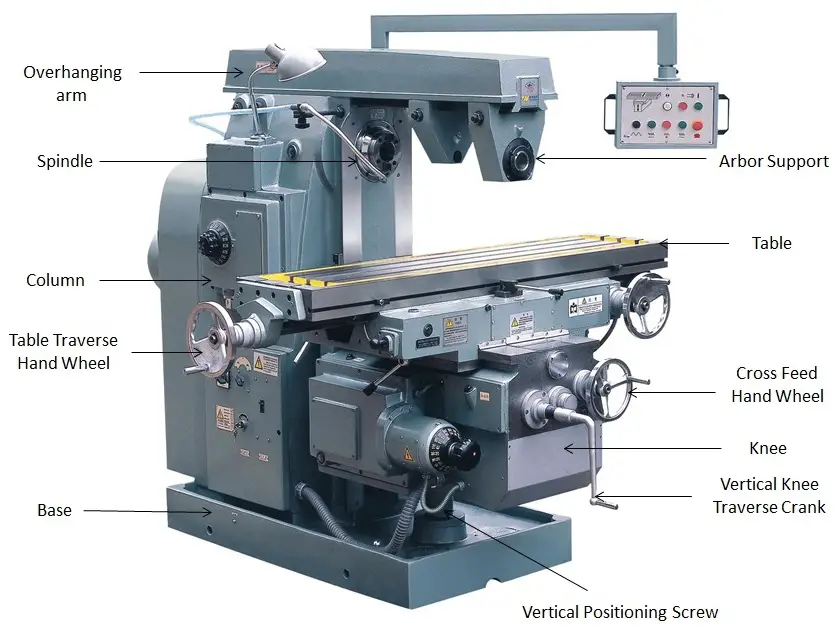In this article you will able to learn about what is milling machine operation, parts and types. Milling machine is the backbone of the manufacturing industries. Almost it is capable of doing any milling operation whether it is gear milling, thread milling, angular milling etc. Here we will discuss about definition, main parts, types and operations of milling machines.
What is Milling Machine?
It is a machine which is used to remove metals from the workpiece with the help of a revolving cutter called milling cutter. It is used to machined the flat, rough and irregular surfaces and this is done by feeding the workpiece against a rotating milling cutter.
Main Parts of Milling Machine
The milling machine main parts are:


1. Column & Base
Column including base is the main casting that supports all other parts of milling machine.
- The column contains an oil reservoir and a pump which lubricates the spindle.
- The column rests on the base and base contains coolant reservoir and a pump which is used during machining operation that requires coolant.
2. Knee
It is a casting that supports the saddle and table. All gearing mechanism is enclosed within the knee.
- It is fastened to the column by dovetail ways.
- The knee is supported and adjusted by a vertical positioning screw (elevating screw).
- The elevating screw is used to adjust the knee up and down by raising or lowering the lever either with the help of hand or power feed.
3. Saddle and Swivel Table
The saddle is present on the knee and supports the table. It slides on a horizontal dovetail on the knee and dovetail is parallel to the axis of the spindle ( in horizontal milling m/c).
- The swivel table (in universal machines only) is attached to the saddle that can be swiveled (revolved) horizontally in either direction.
4. Power Feed Mechanism
It is the knee which contains the power feed mechanism. It is used to control the longitudinal ( left and right), transverse ( in and out) and vertical (up and down) feeds.
- To get the desired rate of feed on the machine, the feed selection lever is positioned as indicated on the feed selection plates.
- On some universal knee and column milling machine, the feed is obtained by turning the speed selection handle until the desired rate of feed is indicated on the feed dial.
- Most of the milling machines have a rapid traverse lever that can be engaged when a temporary increase in the speed of the longitudinal, transverse or vertical feeds is required. For example this lever would be engaged when the operator is positioning or aligning the work.
5. Table
It is a rectangular casting which is present on the top of the saddle.
- It is used to hold the work or work holding devices.
- It contains several T-slots for holding the work and work holding devices (i.e. jigs and fixtures).
- The table can be operated by hand or by power.To move the table by hand, engage and turn the longitudinal hand crank. To move it through power, engage the longitudinal direction feed control lever.
6. Spindle
It is the shaft that is used to hold and drives the cutting tools of the milling machine.
- The spindle is mounted on the bearings and supported by the column.
- Spindle is driven by the electric motor through gear trains. The gear trains are present within the column.
- The face of the spindle which lies near to the table has an internal taper machined on it. The internal taper at the front face of the spindle permits only a tapered cutter holder or arbor. It has two keys at the front face which provides a positive drive for the cutter holder or arbor.
- The drawbolt and jam nut is used to secure the holder and arbor in the spindle.
7. Over Arm / Overhanging Arm
It is a horizontal beam present at the top face of the column. It may be a single casting which slides on the dovetail ways present on the top face of the column.
- The overarm is used to fastened arbor support. It may consist of one or two cylindrical bars which slide through the holes in the column.
8. Arbor Support
It is a casting with bearing that supports the outer end of the arbor. It also helps in aligning the outer end of the arbor with the spindle.
- It prevents the springing of outer end of the arbor during cutting operations.
- There are generally two types of arbor supports used in the milling machine. The first one has small diameter bearing hole, 1-inch in maximum diameter. And the other one has large diameter bearing hole, usually upto 23/4 inches.
- The arbor support has an oil reservoir that lubricates the bearing surfaces. It can be clamped anywhere on the overarm. The arbor support is used only in the horizontal types of milling machine.
9. Ram
The overhanging arm in the vertical machine is called ram. One end of the ram is mounted on the top of the column and on the other end milling head is attached.
- The ram can be a moved transversally ( in and out) on the column by a hand lever.
Also Read:
- Types of Lathe Machine – Mother of all Machines
- Difference Between Up Milling and Down Milling – Which is Better?
- What is CNC Machine – Main Parts, Working, Block Diagram
Types of Milling Machine

Basically the milling machines are divided into two types first is horizontal milling machine and second one is vertical milling machine. They are further classified as knee-type, ram-type, manufacturing or bed type and planer-type milling machine.
Most of the milling machine classified above has self-electric driven motor, coolant systems, power operated table feed and variable spindle speeds.
1. Horizontal Milling Machine
In horizontal milling machine the axis of rotation of the spindle is horizontal to the table. And due the axis of spindle horizontal, it is called as horizontal milling machine.
2. Vertical Milling Machine
The milling machine in which the spindle axis is perpendicular to the table is called vertical milling machine.
3. Knee-Type Milling Machine
The milling machine which has a knee like projection at the middle is called knee-type milling machine. It is characterised by a vertical adjustable work table resting on a saddle supported by a knee.
4. Ram-Type Milling Machine
A milling machine which has a ram on the top of the column is called ram type milling machine. Generally ram is used in vertical milling machine. It can be moved on the column in transverse direction (i.e. in and out when operated from the knee side).
5. Manufacturing or Bed -Type Milling Machine
6. Planer-Type Milling Machine:
Also Read:
- Difference Between Horizontal and Vertical Milling Machine
- Difference Between Capstan and Turret Lathe
- Types of Milling Cutters Used in Machining Process
Milling Machine Operation
The different milling machine operation is:
1. Face Milling
This operation makes flat surfaces at the face of workpiece. This machining operation is done on the surfaces which are perpendicular to the axis of the cutter. The operation is performed by the face milling cutter mounted on stub arbor of the machine.
2. Side Milling
It is the machining process which produces flat vertical surface at the sides of a workpiece. This operation is performed by using side milling cutter.
3. Plain Milling
It is a Process of milling flat surfaces keeping the axis of the cutter parallel to the surface being milled. It is also called surface milling or slab milling. A plain milling cutter is used for the plain milling.
4. Straddle Milling
it is a process in which two side milling cutter are used to machined two opposite sides of a workpiece simultaneously. The straddle milling operation is shown in the figure given below.
5. Angular Milling
It is a process of milling flat surfaces which are neither Parallel nor perpendicular to the axis of the milling cutter. It is also called as angle milling. A single angle milling cutter is used to perform this operation.
6. Gang Milling
It is the machining process in which two or more milling cutters are used together to perform different milling operation simultaneously. In gang milling the cutters are mounted on the arbor.
7. Form Milling
It is the process of machining special contour (outline) composed of curves, straight lines, or entirely of curves, at a single cut. Formed milling cutters shaped to the contour to be cut are used to perform this operation. This operation is accomplish by using convex, concave and corner rounding milling cutters.
8. Profile Milling:
This milling operation is used to cut a profile on the workpiece.
9. End Milling
It is the process of producing flat surfaces which may be horizontal, vertical and at any angle taking worktable as a reference. End milling cutters are used to accomplish this operation.
10. Saw Milling
It is machining process which is used to produce narrow grooves or slots on the workpiece.
- It is also used for the parting off the workpiece into two equal or unequal parts.
- This milling operation is performed by using saw milling cutter.
- The width of the this cutter is very less as compared with the width of the workpiece.
11. Milling Key Ways, Grooves and Slots
This milling operation is used to produce key ways, grooves and slots on the workpiece.
12. Gear Milling
It is the milling process which is used to cut gears on the workpiece. This operation is done by using formed milling cutters called involute gear cutters.
13. Helical Milling
This milling operation is done to produce objects having helical design such as helical gears, twisted drills etc. it is done on the periphery of the cylindrical workpiece.
14. Cam Milling
It is a machining process which is used to make cams. The cams are used to open and close of the valves in the internal combustion engines.
15. Thread Milling
It is the process of milling used to cut threads on the cylindrical workpiece.
This is all about what is milling machine-operation parts and types. If you find any improvement in the article please tell us through your valuable comments. And if you find this article informative & useful, please don’t forget to share.


I didn’t know that a milling machine was used to remove metals from the work piece! That is really interesting that they can so many things! There are so many different types of milling that you listed it is kind of crazy! No wonder they are the backbone of the manufacturing industries! Thank you for all of the information!
I would like that adding it types of milling cutters and specifications of milling machine and working of milling machine and the tool holding devices and work holding devices of milling machine would attract more student to see your website for their reference.
I think making this topics available will be good for all the students assignments and projects !!!
Wow, I never knew that there are a lot of types of milling machines. And thanks for explaining that it’s purpose is to remove metals from the workpiece through feeding it against the cutter. I have been hearing about this a lot lately because my uncle will be buying a number of this equipment for his company. Thanks for the information!
Excellent post. I’m facing some of these issues as well..